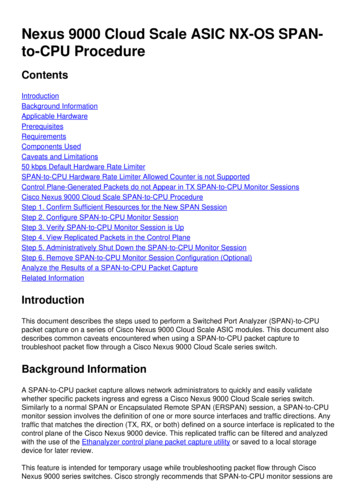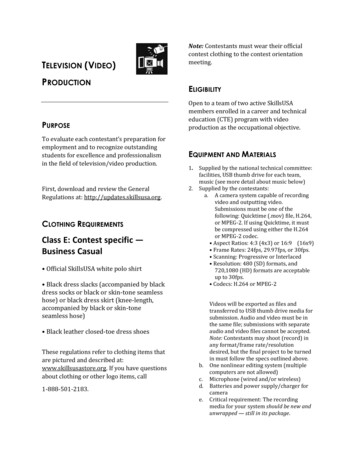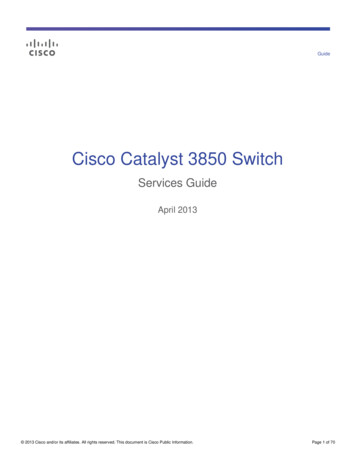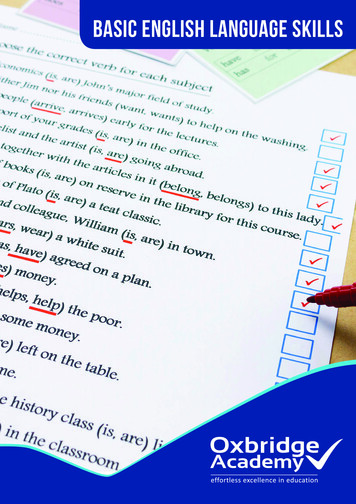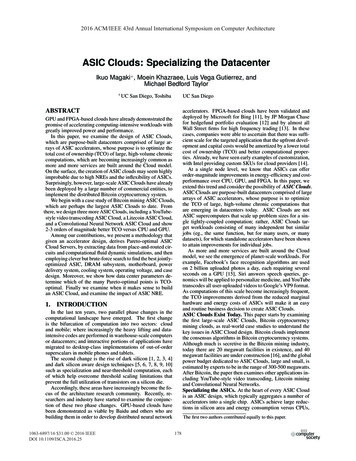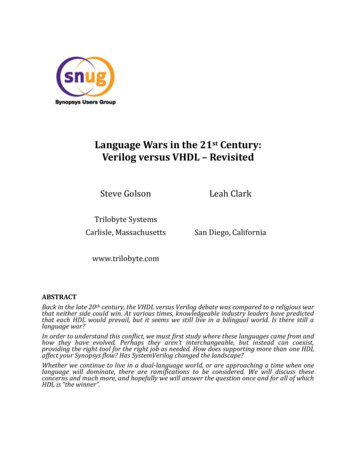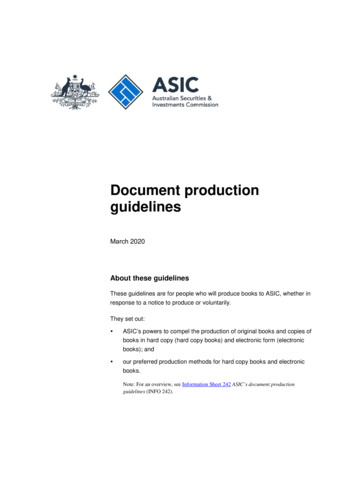
Transcription
Document productionguidelinesMarch 2020About these guidelinesThese guidelines are for people who will produce books to ASIC, whether inresponse to a notice to produce or voluntarily.They set out: ASIC’s powers to compel the production of original books and copies ofbooks in hard copy (hard copy books) and electronic form (electronicbooks); and our preferred production methods for hard copy books and electronicbooks.Note: For an overview, see Information Sheet 242 ASIC’s document productionguidelines (INFO 242).
Document production guidelines (Attachment to INFO 242)ContentsAOverview . 3Purpose of these guidelines . 3Benefits of producing books in accordance with these guidelines . 3Consequences of not following these guidelines . 4Working with ASIC . 4Our preferred production methods for books. 5Use of different review methods . 6BHow to produce books in electronic form. 7Original native file format and litigation support system production . 7Metadata . 7Providing books to ASIC . 8Guidance on producing specific electronic books . 9De-duplication . 12Legal professional privilege . 12CHow to produce hard copy books . 13DProduction protocol for books in a litigation support system. 14General . 14Document IDs and page numbers . 14Documents . 15De-duplication . 19Provision of document metadata . 19Key terms . 26 Australian Securities and Investments Commission March 2020Page 2
Document production guidelines (Attachment to INFO 242)AOverviewKey pointsWe may give you a written notice that requires you to produce specifiedbooks. ‘Books’ includes documents and any other record of information,including: books stored in electronic form (electronic books); and books stored in hard copy (hard copy books).We may also ask you to produce books voluntarily.These guidelines set out ASIC’s powers and explains how we prefer you toproduce books. It covers the production of original books, copies of books,hard copy books and electronic books.Purpose of these guidelines12We may give you a written notice that requires you to produce books (noticeto produce). ‘Books’ includes documents and any other record ofinformation, including electronic and hard copy books. ASIC’s powers toissue a notice to produce are set out in:(a)the Australian Securities and Investments Commission Act 2001 (ASICAct)—see s19, 30, 30A, 30B, 31, 32A and 33;(b)the National Consumer Credit Protection Act 2009—see s256, 266and 267;(c)the Superannuation Industry (Supervision) Act 1993—see s255 and269; and(d)the Insurance Contracts Act 1984—see s11C and 11D.We may also ask you to provide books voluntarily—that is, not in responseto a notice to produce.Benefits of producing books in accordance with these guidelines3These guidelines set out our preferred production methods for books werequire or request in the course of carrying out ASIC’s regulatory functions.Please produce books to ASIC using these methods. This will usually reducethe time, costs and resources:(a)you need to comply with a notice to produce; and(b)we need to process and review your books, including adding the booksto the ASIC litigation support system. Australian Securities and Investments Commission March 2020Page 3
Document production guidelines (Attachment to INFO 242)Consequences of not following these guidelines4If you choose not to produce books in accordance with these guidelines andwe consider it efficient to do so, we may:(a)ask you to produce the books again in a way that accords with theseguidelines; or(b)serve a notice requiring you to produce the device on which thedocuments are stored.5If you choose not to produce books in accordance with these methods, it willlikely cause ASIC to take more time and incur more costs in adding yourbooks to its litigation support system and reviewing your books.6ASIC is likely to make an order under s91 of the ASIC Act to recoverinvestigation expenses and costs if, as a result of our investigation, you areconvicted of an offence or judgment is awarded, or a declaration or otherorder is made against you in a proceeding in a court. Any additionalinvestigation expenses and costs that ASIC incurs because you did notproduce books in accordance with these guidelines may be passed on to youif an order is made.7ASIC may also pass on costs indirectly via ASIC’s industry funding model ifwe incur additional investigation expenses and costs because you did notproduce books in accordance with these guidelines. Costs may be passed oneven if you are not convicted of an offence or no order is made against you ina proceeding in a court or if you are not the subject of ASIC’s investigation.Working with ASICContacting ASIC to discuss the notice to produce8If you have questions about any aspect of the notice to produce, you shouldcontact the ASIC officer named in the notice. Discussing the scope of anotice, including the meaning of certain terms, can often result in significanttime and cost savings.9You may also contact the ASIC officer to discuss the form of production.We may agree to a form of production in those discussions, but the finaldecision about production is yours. These guidelines set out our likelyapproach to various forms of production, to help you in those discussions.10We may also be able to:(a)clarify the scope of the notice and/or the meaning of terms used in thenotice; and(b)provide some technical guidance on ASIC’s preferred forms of production. Australian Securities and Investments Commission March 2020Page 4
Document production guidelines (Attachment to INFO 242)Our preferred production methods for books11ASIC has powers to compel the production of:(a)electronic books, including the metadata associated with the books; and(b)original hard copy books.Electronic books12When producing electronic books, you must produce writing that reproducesthe information in the books in a form we are able to understand. Theexception to this is if the notice to produce directs you to produce the deviceon which the books are stored.Note: See s25A of the Acts Interpretation Act 1901, as in force at 1 January 2005—sees5A of the ASIC Act.13Regardless, we prefer you to produce electronic books, including theirmetadata, in their original native file format. This can be either:(a)the form in which the books are stored—for example, a Microsoft Worddocument from a file server; or(b)the native form in which the system that stores the books exportsthem—for example, an MSG file exported from Microsoft Outlook.14You may also produce books using a litigation support system. If you use alitigation support system to review and produce the books, please follow theproduction protocol in Section D.15There will be some occasions when we are unable to interpret books in theiroriginal native file format. In this case, you must produce the books aswriting that reproduces the information in a form we are able to understand.For guidance on working with ASIC to produce books in an alternativeformat, see paragraphs 9–10.16For further guidance on producing electronic books, see Section B.Original hard copy books17We may require you to produce your original hard copy books. This will beset out in the notice to produce.18If we do not require original hard copy books, you may still produce hardcopies of the original hard copy books. However, we ask that you scan theoriginal hard copy books in accordance with the guidance in paragraphs 68–69and produce these as electronic copies.19For further guidance on producing hard copy books, see Section C. Australian Securities and Investments Commission March 2020Page 5
Document production guidelines (Attachment to INFO 242)Use of different review methods202122There are different approaches to reviewing books and identifying thedocuments that fall under the notice to produce. For example, you mayundertake:(a)a manual review;(b)keyword or concept searches; or(c)a technology-assisted review, such as predictive coding.We encourage you to carefully document your review, including:(a)your approach to the review;(b)how you conducted the review;(c)the decisions you made about the review; and(d)the outcome of the review.We may require you to explain any matter relating to the compilation of anyof the books or to which any of the books relate: see s37(9) of the ASIC Act. Australian Securities and Investments Commission March 2020Page 6
Document production guidelines (Attachment to INFO 242)BHow to produce books in electronic formKey pointsThis section sets out how we ask you to produce books in electronic form.We ask you to produce electronic books in their original native file format,including the metadata associated with the books.You may also produce books using a litigation support system. If you doproduce books this way, please produce them in accordance with theseguidelines.Note: For technical details of how we prefer you to produce books using a litigationsupport system, see Section D.Original native file format and litigation support system production23We request that you produce electronic books in their original native fileformat. If you are producing electronic books using a litigation supportsystem, please follow the production protocol in Section D.24If you use a litigation support system, the provider of the system may be ableto give you guidance on the mechanics of responding to a notice to produce.25If you have questions arising from these guidelines, we may be able toprovide some technical guidance: see paragraphs 9–10.Metadata26Where you produce electronic books to ASIC in accordance with theseguidelines, including when using a litigation support system, you should alsoproduce the metadata set out at:(a)paragraphs 41–42, for recordings of telephone conversations;(b)paragraphs 43–44, for text messages;(c)paragraph 45, for electronic books from document or contentmanagement systems; and(d)paragraphs 93–103, for productions from litigation support systems. Australian Securities and Investments Commission March 2020Page 7
Document production guidelines (Attachment to INFO 242)Providing books to ASICFile formats27We may not be able to understand some electronic books in their originalnative file format. Electronic books kept in an industry-specific or tailoredsoftware format present a particular risk of this. If we require you to producebooks kept in one of these formats, we encourage you to contact us todiscuss alternative production methods and formats for those books.Note: As set out in paragraph 12, you must produce electronic books in a form we areable to understand.Host and attachment documents (document groups)28If a hard copy or electronic book is part of a document group (e.g. an email,its embedded files and attachments), you will usually need to produce theentire document group. This will be set out in the notice to produce.Note: A ‘document group’ may also be called a ‘document family’ in a notice toproduce.29If you are producing electronic books in their original native file format,please ensure that the embedded files remain embedded and the attachmentsremain attached to their host document.30If you are producing hard copy or electronic books using a litigation supportsystem, please provide the embedded or attached files as separate documents,with a host and attachment relationship. The native file of the host documentshould retain the embedded or attached file: see paragraphs 66–67 and 73–77.31The notice to produce will make it clear if you do not need to produce thedocument group associated with a hard copy or electronic book.32For more information about host and attachment documents generally, seeparagraphs 73–77.Media storage33You may produce books in electronic form on a CD, DVD, hard drive orUSB drive, or by email or secure file transfer link.34You may password protect the media on which the books are produced to securethe information in transit to ASIC. However, you must provide the passwordfor this media to ASIC when you produce the books in electronic form.35If you are responding to more than one notice to produce, please use aseparate piece of media for each notice. Australian Securities and Investments Commission March 2020Page 8
Document production guidelines (Attachment to INFO 242)Cover letter36To ensure we correctly record productions in response to notices to produce,please provide a cover letter with each production. The cover letter shouldset out:(a)the identification number (recorded as ‘Our reference’ at the top of thecovering letter to the notice to produce), the notice reference numberand the name of the ASIC staff member who signed the notice;(b)a list of each piece of media included in the production; and(c)if producing under the production protocol, the time zone in whichemails were standardised or normalised during conversion.Virus free37Please ensure the books you produce to ASIC in electronic form are virusfree.Guidance on producing specific electronic booksEmails and chats3839If electronic books are kept in one of the following email or chat systems,please export those emails or chats as follows:(a)Microsoft Exchange emails—PST file (one per custodian) or convertedinto properly formed MSG or EML files, grouped by custodian;(b)Lotus Notes emails—NSF file (one per custodian) or individual nativeEML files, grouped by custodian;(c)Reuters chat system—PST file (one per custodian) or individual nativeMSG files, grouped by custodian; and(d)Bloomberg chat system—PST file (one per custodian), individual nativeMSG files or as a native text package (including all text and XML files,attachment archives and audit logs).If electronic books are kept in another kind of email or chat system, pleasecontact ASIC to discuss how to export and produce these books.Note: As set out in paragraph 12, you must produce electronic books in a form we areable to understand.40We may be able to provide some technical guidance on the production ofemails and/or chats. Australian Securities and Investments Commission March 2020Page 9
Document production guidelines (Attachment to INFO 242)Recordings of telephone conversations4142If recordings of telephone conversations are stored as electronic books withassociated metadata, you will usually need to produce the metadataassociated with the recordings. This will be set out in the notice to produce.Please produce the metadata for the recordings:(a)in their original native file format; or(b)in a structured format agreed in advance with ASIC, along with therecordings.For recordings of telephone conversations, you will usually need to providethe following metadata (assuming it exists):(a)the time and date the call was made. If the call starts on one day andfinishes on another, the date is the date the call started;(b)the time zone the call was made from;(c)the length of the call;(d)the name and telephone number of the person who made the call;(e)the name and telephone number of the person who received the call;(f)if the call was made using a teleconferencing service, the names andnumbers of the teleconference service and all telephone numbers thatwere involved in the teleconference; and(g)the filename of the recording of the call.Text messages43If you are required to produce text messages, you will usually need toproduce the metadata associated with those text messages. The notice toproduce will set this out. Please produce this metadata in a structured format.You should discuss preferred structured formats with ASIC before producingthe text messages.44For text messages, you will usually need to provide the following metadata(assuming it exists):(a)the date and time the message was sent;(b)the time zone the message was sent from;(c)the telephone number from which the message was sent;(d)the telephone number or numbers to which the message was sent; and(e)the filename of the message. Australian Securities and Investments Commission March 2020Page 10
Document production guidelines (Attachment to INFO 242)Document or content management systems45When electronic books are extracted from a document management systemor content management system, or any other type of electronic system (otherthan litigation support systems mentioned at paragraph 52), you must alsoproduce all metadata relevant to the books.Audio and video files46The notice to produce may require you to produce audio or video files. Ifthese files are not in a format playable using Microsoft Windows MediaPlayer or VLC Media Player, you should contact ASIC to discuss how toproduce them in a form capable of being understood by ASIC.Note: As set out in paragraph 12, you must produce electronic books in a form we areable to understand.Encrypted files47You must produce electronic books to ASIC in a form we are able tounderstand: see paragraph 12. This includes encrypted files.48If you are producing documents in their original native file format, pleaseprovide the password for each encrypted document as part of yourproduction.49If you are producing documents using a litigation support system, pleasedecrypt the documents before producing them to ASIC. If you are unable toremove the encryption, you must provide ASIC with all necessary passwordsto decrypt the data.Databases50The notice to produce may require you to produce books containinginformation that is stored in a database. To comply with the notice strictly,you may need to produce the entire database. However, we may accept anextract from the database, rather than the whole database.51You should contact ASIC to discuss whether we require the production ofthe database as a whole or whether we would accept an extract from thedatabase. Note that the extract must be in a form we can understand: seeparagraph 12.Litigation support system52If you produce hard copy or electronic books using a litigation supportsystem, please produce the books in accordance with the production protocolin Section D. Australian Securities and Investments Commission March 2020Page 11
Document production guidelines (Attachment to INFO 242)De-duplication53The notice to produce may require you to produce all duplicate documents.If it does not, you may remove duplicate documents from the producedmaterial (de-duplication).54If you are producing electronic books in original native format, please:55(a)carry out the process of identifying duplicate documents using anindustry-approved hashing algorithm at the document-group level. Thatis, you should only treat all documents within a group (e.g. a hostdocument and its attachments) as duplicates if the entire group ofdocuments is duplicated elsewhere. A standalone document should onlybe de-duplicated against other standalone documents; and(b)preserve the duplicate document(s) and metadata, as we may requireyou to produce the duplicates later.If you are producing electronic books using a litigation support system, seeparagraphs 90–92 for further guidance.Legal professional privilege56Our position on legal professional privilege is set out in InformationSheet 165 Claims of legal professional privilege (INFO 165). Theproduction protocol at paragraphs 85–89 provides further guidance aboutproduction of documents over which you claim legal professional privilege. Australian Securities and Investments Commission March 2020Page 12
Document production guidelines (Attachment to INFO 242)CHow to produce hard copy booksKey pointsThis section sets out how we ask you to produce hard copy books.We usually prefer hard copy books to be scanned and produced inelectronic form. However, a notice to produce may require the production oforiginal hard copy books.57We may require you to produce your original hard copy books. If we requireyou to produce original hard copy books, the notice to produce will say so.58When you produce original hard copy books, they must be produced as theyare and without any modification.59If you do not need to produce original hard copy books, please produceelectronic copies that have been scanned in accordance with paragraphs 68–70.60When you produce hard copies or electronic copies of original hard copybooks, please:(a)ensure we are able to determine the way the originals are stapled orclipped in the copies;(b)provide a copy of any page that has a note or flag and, where that noteor flag obscures information recorded on the page, another copy of thepage with the note or flag removed; and(c)maintain the order of the pages as in the original. Australian Securities and Investments Commission March 2020Page 13
Document production guidelines (Attachment to INFO 242)DProduction protocol for books in a litigationsupport systemKey pointsThis section sets out how we ask you to produce books from a litigationsupport system.This section is drafted for people who work with litigation support systemsand is, necessarily, technical in nature.General61We assign a unique matter prefix to each of our investigations. Before youprepare documents for production, please consult with ASIC about theprefix we have used so that the duplication of document IDs can beavoided.62If you produce books that do not comply with this protocol, we may ask youto produce them again. If the books continue to be non-compliant, we mayserve a notice requiring you to produce the device on which the documentsare stored.Document IDs and page numbers63Each page of each document should be marked with a unique page ID in theformat ‘PPP.BBBB.FFFF.NNNN’ or ‘PPP.BBBB.FFFF.NNNN XX(XX)’(‘XX(XX)’ is an optional element). The page ID on the first page of eachdocument is the document ID.Note: Page numbers following an underscore may be two, three or four digits in length.64For information on the meaning of each part of the document IDs and pagenumbers, see Table 1.Table 1:Document IDs and page numbersLevelDescriptionPPPThe prefix (also known as ‘party code’ or ‘source’) identifies thesource or owner of the documents and should be agreed withASIC to ensure it does not clash with ASIC’s documentnumbering. Australian Securities and Investments Commission March 2020Page 14
Document production guidelines (Attachment to INFO 242)LevelDescriptionBBBBThe box number identifies a specific physical archive box, emailmailbox, or any other container or physical or virtual classificationthat is appropriate for you to use.It may be padded with zeros to ensure a consistent four-digitstructure.FFFFThe folder number identifies a physical folder, subfolder or anyother subcontainer.It may be padded with zeros to ensure a consistent four-digitstructure.NNNNThe page number refers to each individual page within each folderfor paper documents, unsearchable images and searchableimages.It may be padded with zeros to ensure a consistent four-digitstructure.XX(XX)The suffix page number is an optional page number that you mayuse: if additional pages need to be inserted into a document; or to number the pages of multi-page PDF documents renderedfrom original native files.The number will be prefixed with a single underscore. It will alsobe padded with zeros to consistently result in a two-digit, threedigit or four-digit structure.DocumentsHard copy books65If we do not require the production of original hard copy books, we ask youto scan all hard copy books as PDF files. Please ensure that the files complywith the requirements set out in paragraphs 68–70.Electronic books66When producing electronic books using a litigation support system, pleaseproduce each document as both:(a)a PDF rendering of the file or, if the document is not suitable for PDFrendering, a placeholder (see paragraph 67(f)); and(b)the native file from which the PDF was generated. The original nativefile of the host document should retain the embedded or attachedfiles. Documents subject to privilege are an exception to this (seeparagraphs 85–89). Australian Securities and Investments Commission March 2020Page 15
Document production guidelines (Attachment to INFO 242)67When producing books using a litigation support system, please:(a)process electronic files to extract attachments to emails and embeddedfiles. Produce the extracted file as an individual document and treat it asan attachment;(b)fully extract the contents of container files (such as ZIP files) andproduce them as separate documents. Do not produce the container fileitself. If you are not able to extract the contents due to a technical issue,produce the container file with its contents in place;(c)decrypt all encrypted materials before production. If you are unable toremove encryption, you must provide ASIC with all necessarypasswords to decrypt the data;(d)do not produce logos and email footers as individual attachments;(e)where practicable, directly render all electronic files to PDF files thatcomply with the requirements set out in paragraphs 68–70; and(f)if an electronic file is not suitable for PDF rendering, provide a PDFplaceholder document that contains the document ID and the following(or similar) text:This is a placeholder. Please refer to native. The PDF placeholderfile is named ‘PPP.BBBB.FFFF.NNNN PH.pdf’.Note: For more information, see paragraph 83.PDF file specifications686970When you create a PDF file—either by scanning a hard copy book orrendering an electronic book—please ensure the file is:(a)a multi-page PDF file (i.e. not one PDF file per page in the document); and(b)text searchable.When you scan hard copy books, please ensure the file:(a)is in colour only if colour is necessary to understand the content; and(b)has a minimum 300 dpi resolution.Only render electronic books in colour if the electronic form in which theyare stored is in colour.Native file specifications71Produce one file for each document in its original native file format.72If you cannot provide the file in its original native format, provide it:(a)in a near-native format, as agreed with ASIC; and(b)with the metadata of the original document. Australian Securities and Investments Commission March 2020Page 16
Document production guidelines (Attachment to INFO 242)Host and attachment documents (document groups)73A document is a ‘host’ where it has one or more documents attached to it.Note: A container file (e.g. a ZIP file) is not a ‘host’ for the purposes of this protocol.74A document is an ‘attachment’ where it is embedded within or attached toanother document. Insert the document ID of the host in the Host Referencefield of the attachment.75A group of two or more documents that bear host and/or attachmentrelationships to other documents in the group (e.g. email and attachments,embedded files) are a ‘document group’.Note: A ‘document group’ may also be called a ‘document family’ in the notice toproduce.76If a document that must be produced is part of a document group, you mustproduce the entire document group (unless the notice to produce requiresotherwise).77Produce document groups together and paginate them sequentially, with theattachment(s) following the host. Insert the document ID of the host in theHost Reference field of the attachment.Document labelling and stamping78Label all PDF document pages (other than native PDF files) with a standardpage number in the format ‘PPP.BBBB.FFFF.NNNN’.79If a document includes underscore pages, label those pages with anunderscore page number in the format ‘PPP.BBBB.FFFF.NNNN XX(XX)’,where ‘XX(XX)’ is a two-digit, three-digit or four-digit suffix number.Directory structure and file naming conventions80Place all files in directories and subdirectories. The subdirectory structureshould reflect the levels in the numbering style (e.g.‘PPP\BBBB\FFFF\PPP.BBBB.FFFF.NNNN.ext’) where:(a)PPP is a directory, which is the three-character prefix;(b)BBBB is a subdirectory, which is the four-digit box number; and(c)FFFF is a subdirectory, which is the four-digit folder number.81The filename structure for each scanned hard copy PDF file is‘PPP.BBBB.FFFF.NNNN.pdf’.82Only alphanumeric characters, underscores and full stops are permitted infile and folder names. Australian Securities and Investments Commission March 2020Page 17
Document production guidelines (Attachment to INFO 242)83The filename structure for electronic books is based on whether the originalnative file was rendered to PDF or given a placeholder: for more informationon placeholders, see paragraph 67. Name files in the PDF and original nativefile combinations are set out in Table 2 (also note the special case fornaming of rendered and native PDF files).Table 2:84PDF and original native file naming conventionsFile typePDF fileOriginal native 01.docxRendered PDFXYZ.0001.0001.0001.pdfXYZ.0001.0001.0001 N.pdfPlaceholderXYZ.0001.0001.0007 PH.pdfXYZ.0001.0001.0007.xlsThe pages table—discussed at paragraph 103 and set out at Table 8—shouldrefer to
books. 'Books' includes documents and any other record of information, including: books stored in electronic form (electronic books); and books stored in hard copy (hard copy books). We may also ask you to produce books voluntarily. These guidelines set out ASIC's powers and explains how we prefer you to produce books.


